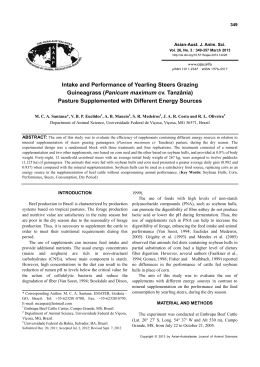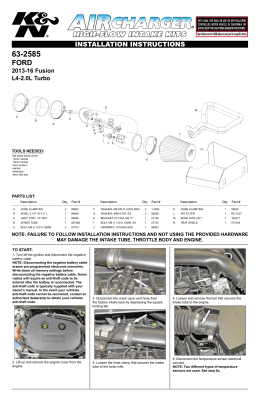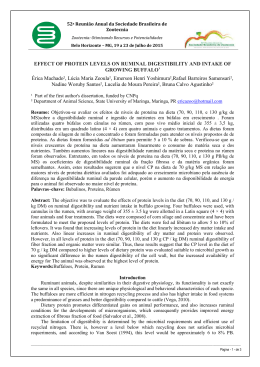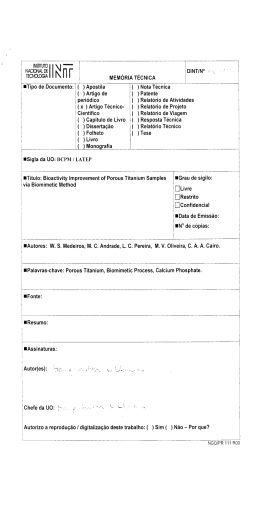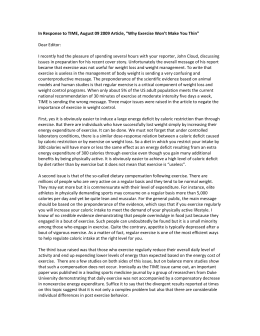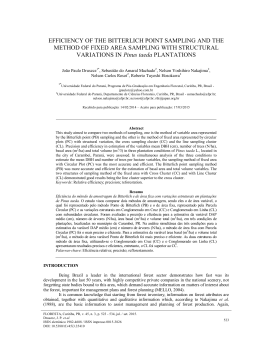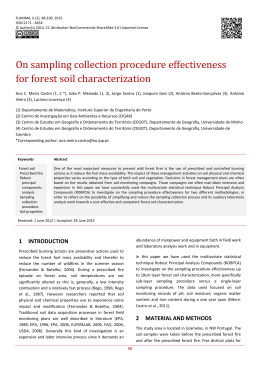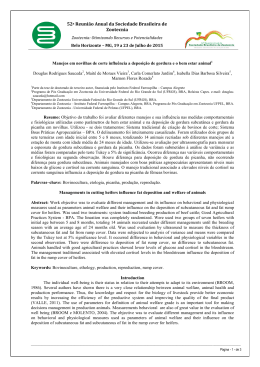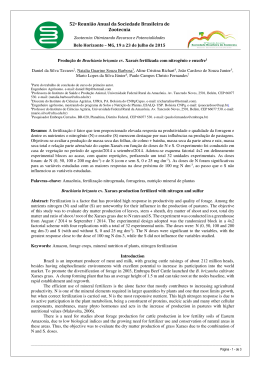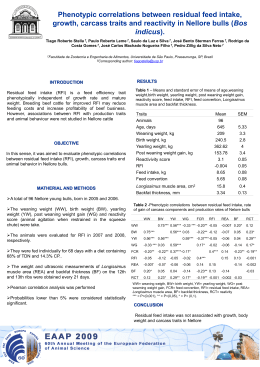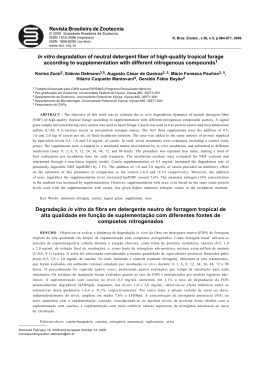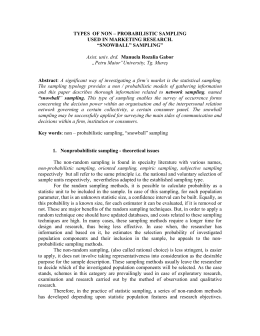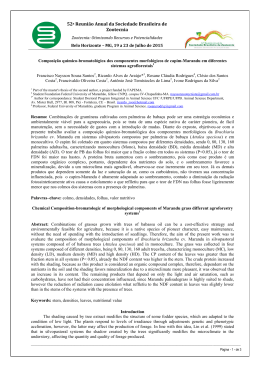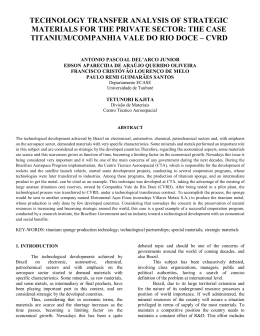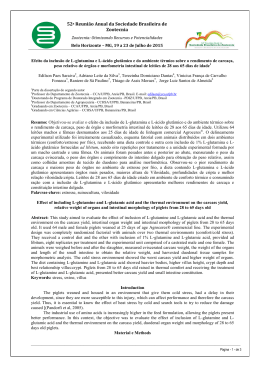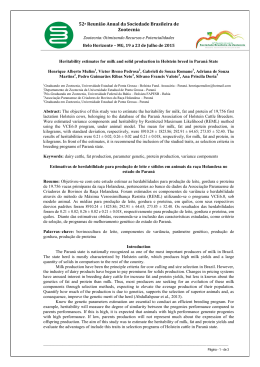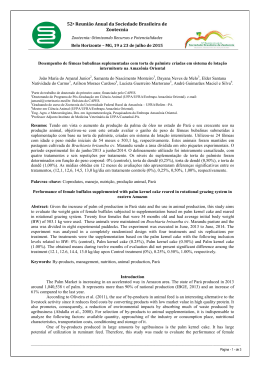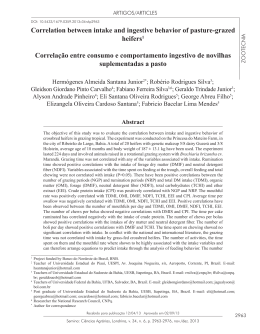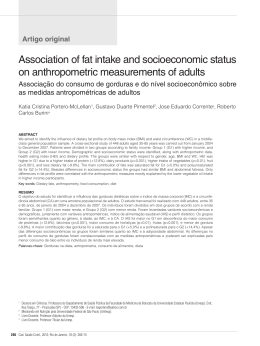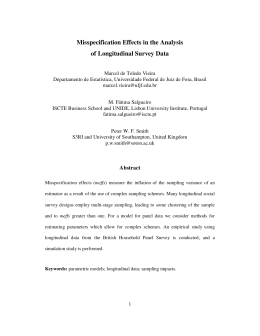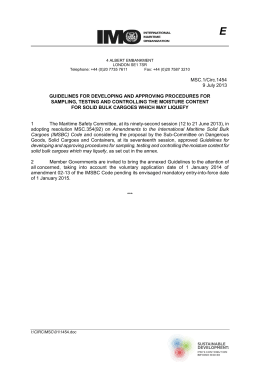52a Reunião Anual da Sociedade Brasileira de Zootecnia Zootecnia: Otimizando Recursos e Potencialidades Belo Horizonte – MG, 19 a 23 de Julho de 2015 Indicadores externos para estimar consumo de forragem em ovinos1 Camila Celeste Brandão Ferreira Ítavo2, Marlova Cristina Mioto da Costa3, Luís Carlos Vinhas Ítavo2, Alexandre Menezes Dias2, Letícia da Costa Rezende3, Eduardo Souza Leal4, José Carlos da Silva Florêncio Filho5 1 Parte da dissertação de mestrado do segundo autor, Faculdade de Medicina Veterinária e Zootecnia da Universidade Federal de Mato Grosso do Sul – FAMEZ/UFMS, Campo Grande-MS. e-mail: [email protected]; [email protected]; [email protected] 3 Programa de Pós-Graduação em Ciência Animal – FAMEZ/UFMS, Campo Grande-MS, Brasil. Bolsista CNPq/Capes. e-mail: [email protected]; [email protected] 4 Programa de Pós-Graduação em Ciências ambientais e Sustentabilidade agropecuária – UCDB. Grande-MS, Brasil. Bolsista Capes. e-mail: [email protected] 5 Curso de graduação em Zootecnia – FAMEZ/UFMS, Campo Grande-MS. e-mail: [email protected] 2 Resumo: Objetivou-se avaliar dois métodos de coleta de fezes (total e retal) e dois períodos de amostragem (5 e 3 dias) por meio de indicadores internos como estimadores da produção fecal para obtenção de estimativas do consumo de forragem. Foram utilizados seis ovinos machos castrados, fistulados no rúmen, com 48,62 ± 2,73 kg PV, mantidos em baias individuais (3 m2), alimentados exclusivamente com capim-Marandu in natura, colhido diariamente, picado e fornecido ad libitum. O experimento foi composto por dois períodos de 12 dias, sendo 7-dias de adaptação e 5-dias de coletas de forragem, sobras e fezes. Foram usados óxido crômico (Cr2O3) e dióxido de titânio (TiO2) como indicadores externos. As fezes foram colhidas para se obter uma amostra composta e a amostra retal foi colhida diretamente da ampola retal, 30 minutos antes do primeiro arraçoamento, momento em que as bolsas coletoras eram esvaziadas, a fim de evitar perda amostral da coleta total. Não houve efeito (P>0,05) na composição bromatológica da forrageira oferecida em função do período de coleta. Não houve efeito do período de amostragem para consumo de matéria seca, 890,12 g / dia. Não houve diferença entre consumo observado e estimado nos dois método de coleta de fezes. Houve efeito do período de amostragem para o óxido crômico, com média de 933,74 e 1026,32 g / dia, por 5 e 3 dias, respectivamente. Óxido crômico e dióxido de titânio como indicadores externos são recomendados para estimar o consumo de forragem por ovinos para a amostragem por cinco dias. Palavras–chave: estimativa de consumo, indicadores externos, lignina, líquido ruminal de ovinos, metodologia de coleta, período de amostragem External markers to estimate of forage intake in sheep Abstract: It was aimed to evaluate two feces collection methods (total and rectal) and two sampling periods (5 and 3 days) using internal markers as estimators of fecal output for to obtain the estimative of forage intake. Six wether sheep, undefined breed, rumen-fistulated, were used with 48.62 ± 2.73 kg BW; kept in individual pens (3 m2) and were fed exclusively with Marandu-grass in natura. Daily the forage was harvested, chopped and provided ad libitum. Trial consisted of two 12 days periods (7 days for adaptation and 5 days for sample collections). Sampling of forage, orts and feces were carried out by five or three consecutive days. Chromic oxide (Cr2O3) and Titanium dioxide (TiO2) as external markers were used. Feces were collected to obtain a composite sample, and rectal sample was taken directly from the rectum 30 minutes before the first feeding, at which time the collection bags were emptied to avoid sample loss of total collection. There was no difference between chemical composition of the forage harvested supplied in two sampling periods (5 and 3 days). There was no effect of sampling period (5 and 3 days) for dry matter intake, 890.12 g/day. There was no difference between intake observed and estimated on two feces collection method. There was effect of sampling period for Chromic oxide, averaging 933.74 and 1026.32 g/day, for 5 and 3 days, respectively. Chromic oxide and Titanium dioxide as external markers are recommended to estimate the forage intake by sheep for sampling by five days. Keywords: collection methodology, intake estimative, internal markers, lignin, sampling period, sheep rumen fluid Introduction Improved estimation of dry matter intake (DMI) for animals raised on pasture has always been a challenge for researchers, especially in the sheep breeding, in view of the large number of variables that act and the limitations imposed by the methods used to obtain these estimates (Morenz et al., 2006). The conventional method used to obtain qualitative estimates is carried out by total collection, which is very labor intensive and in certain circumstances, such as the keeping of animals on pasture, it is very difficult to be _____________________________________________________________________________________________________________________________ ___________________ Página - 1 - de 3 52a Reunião Anual da Sociedade Brasileira de Zootecnia Zootecnia: Otimizando Recursos e Potencialidades Belo Horizonte – MG, 19 a 23 de Julho de 2015 realized, a fact which induced the development indirect valuation methods, such as using markers (Zeoula et al., 2000). The external markers are a variety of inert compounds, administered to the animals, and the limitation of not behave as particles of food, and when adhered to its fibrous portion may change some chemical and physical characteristics, such as the specific gravity (Ehle et al., 1984). The chromic oxide (Cr2O3) has been the most widely used, due to their ease of incorporation into the diets and the relatively low cost (Canesin et al., 2012) however Titgemeyer et al., (2001) stressed that the chrome is not approved by the Food and Drug Administration (FDA) as a food additive. On the other hand appears the titanium dioxide (TiO2) as an alternative, as it can be legally added to the food provided (Ferreira et al., 2009). Inside this context, it was aimed to evaluate two feces collection methods (total and rectal) to estimating forage intake by sheep through external markers. Material e Methods The experiment was conducted in the period between November to December 2013 in the Laboratory of Animal Metabolism, Faculty of Veterinary Medicine and Animal Science (FAMEZ) of the Federal University of Mato Grosso do Sul (UFMS), Campo Grande - MS. Six castrated male sheep, undefined breed, fistulated in the rumen, with average body weight of 48.62 ± 2.73 kg derived from the Sector of Sheep of FAMEZ/UFMS were used. All animals were fed exclusively with Brachiaria brizantha cv. Marandu in natura. Daily the forage was harvested, chopped and provided ad libitum in individual feeders, supplied in two portions 8 and 17 h, allowing leftovers 5 to 10% of the total supplied. The animals were kept in individual pens with 3 m² with slatted floor fitted the feeders and drinkers. The trial consisted of two experimental periods of 12 days, seven days for food to adapt to obtain a plateau intake and homogeneous fecal excretion. Sampling of forage, orts and feces were carried out by three and five consecutive days. The feces were collected in order to obtain a composite sample per animal/trial period/collection method (Total and Rectal)/collection period (3 or 5 days) and the rectal sample was harvested directly from rectal ampulla, 30 minutes before the first feeding, moment in which the collecting bags were emptied, in order to avoid loss of sample of the total collection. The experimental design was a randomized cross over, where in each sampling period, three animals received each type of external marker being that at the end of the experiment, all animals received the two external markers. These (chromic oxide and titanium dioxide) were weighed, packaged in filter paper and infused in the rumen of animals, through the cannula, 4 g/animal/day, at the same time that it was made the sampling rectal, 30 minutes before the first feeding. The fecal output estimates were used to obtain estimative of intake. All data were submitted to analysis of variance. When a significant F-test was detected, means were separated using the Student’s test for fecal collection method (Total vs. Rectal) and Dunnet test for markers. Results and Discussion There was no statistical difference (P>0.05) in the evaluation of the chemical composition of the forage harvested provided in the sampling period, 5 and 3 days. It is highlighted that lignin content was high 67.9 g/kg. The CP content was 69.06 g/kg, and the NDF and ADF content were 717.56 and 415.58 g/kg, respectively (Table 1). These results indicate that chemical composition of forage did not alter within sampling period. Table 1. Chemical composition of the forage (Brachiaria brizantha cv. Marandu) offered in function of sampling period. Sampling period SEM P1 5 days 3 days DM (g/kg) 235.96 237.97 0.051 0.663 OM (g/kg MS) 906.33 907.48 0.017 0.467 CP (g/kg MS) 69.26 68.87 0.080 0.955 NDF (g/kg MS) 716.80 718.32 0.037 0.655 ADF (g/kg MS) 414.45 416.71 0.125 0.838 Lignin (g/kg MS) 67.85 67.95 0.028 0.965 SEM = Standard Error of mean P1 = Effect of sampling period (5 days x 3 days) The intake esteemed by external markers on the total collection of feces method, chromic oxide and titanium dioxide have average of 1008.77 and 997,94 g/day, respectively, which did not differ statistically from the fecal _____________________________________________________________________________________________________________________________ ___________________ Página - 2 - de 3 52a Reunião Anual da Sociedade Brasileira de Zootecnia Zootecnia: Otimizando Recursos e Potencialidades Belo Horizonte – MG, 19 a 23 de Julho de 2015 output observed, 890.12 g/day (P> 0.05). However, on the rectal collection of feces method, the obtained of Titanium dioxide showed tendency (P>0.05 and <0.10) to differ of intake observed result. Titanium dioxide estimative presented same behavior when sampling by 5 days. These results may have been influenced by the high standard error of the mean (SEM = 17.095). So it can be inferred that both chromium oxide and titanium dioxide markers may be used as estimators of fecal output for to estimate intake in sheep using total feces collection methodology (Table 2). Also Ferreira et al., (2009) evaluated chromium and titanium in heifers, have noted that these expressed similar values. Table 2. Dry matter in take observed and estimated by external makers chromic oxide (Cr2O3) and titanium dioxide (TiO2) in function of collection of feces (Total and Rectal) and sampling periods (5 and 3 days). Collection method of Sampling periods feces SEM P1 P2 P3 Total Rectal 5 days 3 days Observed 890.12 890.12* 891.85 888.39 3.064 0.778 0.778 0.778 Cr2O3 1008.77 951.29 933.74 b 1026.32 a 3.301 0.177 0.032 0.093 TiO2 997.94 1290.76 1058.59 1230.12 17.095 0.184 0.433 0.180 SEM 2.241 8.886 3.675 9.015 P4 0.218 0.058 0.067 0.168 1 Means followed by different capital letters in the same column differ by Dunnett test (P<0.05) Means followed by lowercase letters in the same line, different by t test (P<0.05) * It was used to average the total collection observed for comparison purposes P1 = Effect of collection method of feces (Total x Rectal) P2 = Effect of sampling period (5 days x 3 days) P3 = effect of the interaction effect of method x feces collection period P4 = Effect of maker x total feces collection (observed x estimated) 2 External markers were able to estimate the dry matter intake (Table 2). There was no statistical difference (P>0.05) between method of collection and external marker, when compared to the dry matter intake observed. However when we analyzed the sampling period, there was difference (P< 0.05) between 5 and 3 days of sampling, the results of sampling by 3 days overestimated the dry matter intake. Thus, the use of sampling by 5 days was more suitable for obtaining the estimated. Conclusions Chromic oxide and Titanium dioxide as external markers are recommended to estimate the forage intake by sheep for sampling by five days. References CANESIN R.C.; FIORENTINI, G.; BERCHIELLI, T.T. 2012. Inovações e desafios na avaliação de alimentos na nutrição de ruminantes. Revista Brasileira de Saúde e Produção Animal 13:938-952. EHLE, F.R.; BAS, F.; BARNO, B.; MARTIN, R.; LEONE, F. 1984. Particulate rumen turnover rate measurement as influenced by density of passage marker. Journal of Dairy Science 67:2910-2913. FERREIRA, M.A.; VALADARES FILHO, S.C.; MARCONDES, M.I.; PAIXÃO, M.L; PAULINO, M.F.; VALADARES, R.F.D. 2009. Avaliação de indicadores em estudos com ruminantes: digestibilidade. Revista Brasileira de Zootecnia 38:1568-1573. MORENZ, M.J.F.; SILVA, J.F.C.; AROEIRA, L.J.M.; DERESZ, F.; VÁSQUEZ, H.M.; PACIULLO, D.S.C.; LOPES, F.C.F.; ELYAS, A.C.W.; DETMANN, E. 2006. Óxido de cromo e n-alcanos na estimativa do consumo de forragem de vacas em lactação em condições de pastejo. Revista Brasileira de Zootecnia 35:1535-1542. TITGEMEYER, E.C.; ARMENDARIZ, C.K.; BINDEL, D.J.; GREENWOOD, R.H.; LOEST, C.A. 2001. Evaluation of titanium dioxide as a digestibility marker for cattle. Journal of Animal Science 79:1059-1063. ZEOULA, L.M.; KASSIES, M.P.; FREGADOLLI, F.L.; PRADO, I.N.; BRANCO, A.F.; CALDAS NETO, S.F.; DALPONTE, A.O. 2000. Uso de indicadores na determinação da digestibilidade parcial e total em bovinos. Acta Scientiarum 22:771-777. _____________________________________________________________________________________________________________________________ ___________________ Página - 3 - de 3
Download
